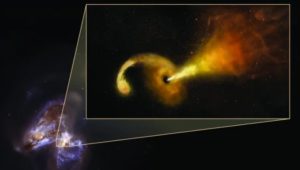Supermassive black hole lies 150 million light years away

It’s probably one the most massive belches you’ll ever see.
For the first time, astronomers have directly imaged material being ejected from a supermassive black hole after it ripped apart an unlucky star.
The centre of most galaxies are believed to contain a supermassive black hole, which can be millions of times more massive than our sun. A star that wanders too close to a black hole will be ripped apart by its gravitational pull, its material falling into the black hole where nothing can escape, not even light.
But as the material is torn apart, it first forms a disk around the black hole.
Only a handful of these tidal disruption events (TDE) have ever been detected.
But now astronomers — using radio and infrared telescopes, which see in wavelengths invisible to the human eye — have observed a TDE in action, where some of the material is ejected out into space from the poles of the disk.
The TDE is occurring around a supermassive black hole in a pair of colliding galaxies called Arp 299, nearly 150 million light-years away. The emission was first discovered in 2005.
Though it was believed that the emission should also show up in optical telescopes, nothing was observed in either visible or X-ray emissions.
“As time passed, the new object stayed bright at infrared and radio wavelengths, but not in visible light and X-rays,” Seppo Mattila, of the University of Turku in Finland, said in a statement. “The most likely explanation is that thick interstellar gas and dust near the galaxy’s centre absorbed the X-rays and visible light, then re-radiated it as infrared.”
Astronomers continued monitoring the event using the Very Long Baseline Array (VLBA) telescope in Hawaii and saw it expanding over the years, just as theorized.
Initially, the researchers believed the brightening was a supernova — a violent stellar death that ends in an explosion. Six years later, the researchers realized that the emission was becoming elongated, which ruled out a supernova.
The team hopes that this new finding will help them reveal more of these TDEs and lead to a better understanding of galaxy formation.


